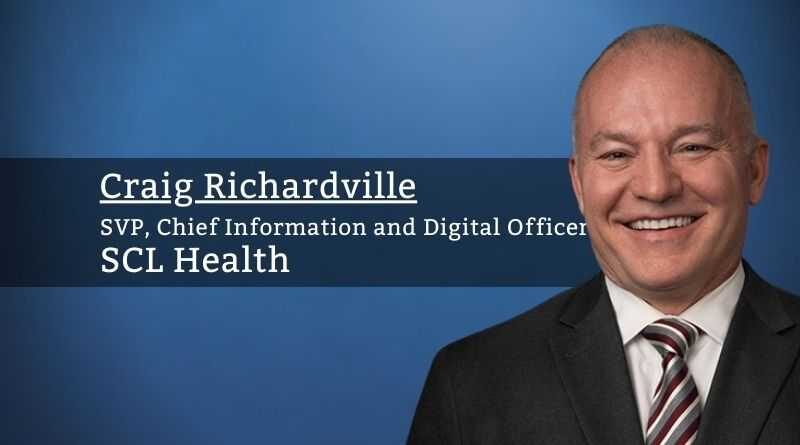Optimizing EHR value, documentation quality, and physician and patient experiences with Ambient AI
By Craig Richardville, SVP, Chief Information and Digital Officer, SCL Health
One of the more interesting challenges that health system IT executives face today is evaluating and prioritizing new clinical applications for AI. Among the rapidly expanding number of innovations covering nearly every aspect of health system clinical and administrative operations, ambient AI is one of the more compelling technologies because of the immediate and longer-term value it provides. In our experience, the process of implementing an ambient AI solution can also serve as a model for testing and deploying other advanced intelligence solutions.
Our journey to ambient AI
We first considered ambient AI technology after Nuance Communications introduced its DAX system in late 2019 to mitigate physician burnout by reducing clinical documentation workloads. We were generally familiar with the Nuance system because it uses speech processing technology that evolved from its Dragon Medical One software used by physicians at SCL Health and other health systems. In mid-2021, we began deploying Nuance’s DAX system at our $2.8 billion faith-based, nonprofit healthcare organization serving patients in Colorado, Montana and Kansas.*
The tool works automatically in the background, securely capturing conversations between clinicians and patients during in-person or telehealth visits. The keyboard and screen that typically require the physician’s attention are replaced by an unobtrusive, low-cost device like a smartphone or tablet. DAX records and converts the interaction into AI-generated clinical notes which are routed through a quality review process to ensure accuracy. The system continuously learns and becomes increasingly accurate and efficient with each word.
The resulting documentation is presented to clinicians to quickly and easily review and approve in the EHR system as part of their day-to-day workflow. If a physician has any questions about the generated notes, the recorded interaction is available for review.
Goals and deployment plan
We first defined how the system aligned with our strategic goals for improving physician satisfaction, expanding digital patient engagement, and using EHR system as a platform for innovation. We also viewed our implementation of the Nuance system as a critical opportunity to work with a technology vendor as a trusted partner vs. following the traditional buyer-supplier model.
We then identified cohorts of providers as early adopters. We included specialties best suited for DAX usage including cardiology, orthopedics, and other clinical areas with relatively standardized terminology and exam procedures. We also incorporated family medicine providers to assess the system’s ability to learn more diverse vocabulary and patient scenarios. In addition, physician need was determined by analyzing signal data from our Epic EHR showing providers who spent more time working on documentation either during or after clinic hours.
We narrowed an initial target list of 50 providers to 25, 10 of whom declined to participate in the initial deployment for various reasons. Deployment began in May, followed in September by an assessment of system performance in a total of 5,426 patient encounters.
AI outcomes and benefits
We evaluated the AI system’s performance based on:
- Increased operational efficiency through reduced documentation time, increased throughput, and greater access to care:
- An average of 13minutes saved per encounter (family medicine)
- A 50% reduction in physician documentation time
- An average of 1.7 appointments added per clinic day (family medicine)
- Higher clinician satisfaction from reduced administrative workloads and higher quality documentation:
- 50% reduction in feelings of burnout and fatigue
- 60% of physicians were satisfied with documentation turnaround time
- 60% would be disappointed if they no longer had access to this system
- 70% of physicians say the system has improved documentation quality
- Better financial outcomes through time savings and incrementally higher revenue from more accurate clinical documentation and appropriate coding:
- $104,537 in annual added value through time-saving per provider (family medicine)
- Improved provider and patient experiences with clinicians feeling more rested, focused, and engaged with patients, and patients having positive experiences in encounters with physicians using AI. Patients familiar with consumer voice applications felt comfortable with the system and felt they had chosen modern, well-equipped providers and facilities:
- 80% overall increase in the quality of the overall patient experience
- 60% of physicians report higher-quality patient interactions
- 70% of patients report an increase in provider face time
Additionally, documentation turnaround time steadily declined from 5.26 hours in May to 2.19 hours in September, while utilization of the system increased to 60% of scheduled appointments.
Today, we have a fully voice-enabled and ambient exam room environment using this AI technology. The system frees clinicians to focus on their patients, gives them back time in their day, and enables them to practice at the top of their license. From an IT perspective, the system reduces complexity because it enables a single cloud platform and single workflow solution for all clinical environments.
Implementing ambient AI represents an opportunity to establish partnerships with IT vendors.
Best practices and outlook
Implementing ambient AI represents an opportunity to establish partnerships with IT vendors. We worked closely with Nuance, collaborating on everything from iterative system changes and improvements to pricing, and making service level agreements and shared risk an integral part of our relationship. In addition, Nuance has consistently shown a willingness and ability to respond to user feedback. The DAX systems we use today are small, inexpensive devices that replaced the bulky, wall-mounted, first-generation designs introduced in 2019.
We also worked closely with physicians who understood the challenges and opportunities of implementing ambient AI to empower them as technology champions for their peers.
Looking ahead, we plan to offer DAX to clinicians in other clinical areas through a repeatable process of expanding small, targeted deployments to more users, incorporating learnings from each one to maximize the value of our investment. We see this process as a transferable model to future implementations of advanced technologies.
* SCL Health and Intermountain Healthcare are planning to merge in early 2022 and form a 33-hospital system with more than 58,000 caregivers across six states and provide about one million people with health insurance.



